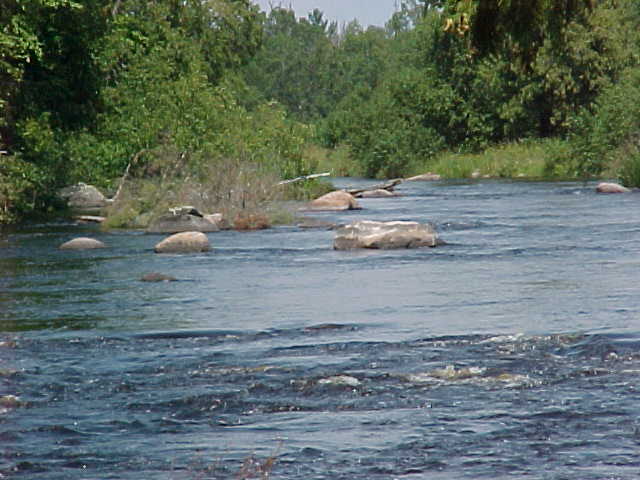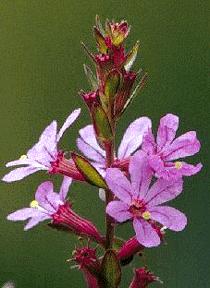| Home Page
Photo Page
Whats New Page
|
|
 |
Introduction of our Lake Association Officers
2002-2003 Wolf River Lakes and Streams Association Officers are:
Jim Jilek, President
Dave Wager, Vice-President
Diane Hietpas, Secretary/Treasurer |
Minutes of Meeting for Wolf River Lakes and Streams Assoc. for July 5, 2003
The meeting of the Wolf River Lakes and Streams Assn. was called to order at 9:05 am. Each person present introduced themselves and what body of water they were associated with.
The guest speaker was Dave Siebel, Fisheries Manager with Antigo DNR, who discussed fish stocking and electro-shocking. Some of the results are that in Sawyer Lake walleye are naturally produced fish in the 4 and one-half inch to 9 inch range. There is a good range of walleye in the 14 inch to 19 inch range. Their opinion was that walleye are in good shape. Small mouth bass 2-5 inch are natural reproduced fish as a result of stocked fish. 8-10 inch fish are the size of the stocked fish. 97-98-99 was the stocking years and a 2-3inch fish in size was planted. Largemouth, which is native, is doing real well. 7-9 inch fish are from year 2000, 10-23 inch fish are from the year 1999, and a good size group of 13-14 inch fish.
Pan fish only were collected for one-half hour at 2 five-minute stations. Lots of bluegill are limiting themselves to 7-9 inch. Rock bass that eat the crawfish, probably are not native to Sawyer.
Electrofishing on Rose Lake was done in the fall of 2002.
Bag limit is set by court order per tribal harvest on Sawyer and Rose Lakes. Sawyer Lake was speared this year. Rose Lake was not and that is the reason for the difference in the bag limit. The bag limits are 5 for Rose and Jessie Lake, and 2 for Sawyer Lake. This will change each year depending on if the lake is speared, and how many walleye are taken.
Size limit is set to take advantage of small, slow-growing walleye. This helps to thin the poor fish from quantity of fish. 12 walleye were speared at Sawyer Lake by the tribe. There was (1) 19.3 inch female, and (11) 14.3 inch to 16.2 inch males speared. The DNR calculated a safe harvest of 21 walleye which is based on the last lake survey which is in excess of 10 years old. Actual fish population found by a lake study would be factored into recalculating the safe fish harvest, which is total walleye which could be taken for the year without being detrimental to the fish population. If the tribe took 21 fish during the spearing we would have had a zero bag limit. If a survey was done, the tribe may be able to raise their limit to spear. They may only take one fish over 20 inch, the rest must be less. A survey would also find out why the bluegills are so small. They may be slow growing and dying of natural causes.
Some Rose Lake members would like to stop stocking of walleye. They would like to see the pan fish grow in size. The fall survey would suggest whether or not to stock walleye for next year.
Frank Jaeger asked about the walleye limit for Jessie vs. Sawyer Lake. Would you get stopped if you crossed Sawyer from Jessie? The answer was you are not able to possess over the limit of Sawyer Lake. The extra fish would be illegal. The difference in lake regulation exists because of tribal regulations.
Siebel, in wrapping up, believes our lakes are doing very well and seem to be reproducing naturally. More spring shocking and a survey would give us a better idea of fish quantity. Sawyer Lake may be a project lake by 2004 because of the budget cycle. Regulation changes cannot be done until these studies are done. He also stated that to promote growth, the large size bluegills should be released. 5-6 inch harvested would promote larger bluegill growth. These are called sneaker males and will never grow large. The larger bluegills, if released, are the males that take longer to mature and are the nest guarders. They are the promoters of large growth.
The Secretaries report was given and a motion was made to accept the minutes.
The Treasurers report was given and a motion was made to accept the report. We agreed to again pay the WAL dues of 125.00/year and someone should volunteer to participate in the conference. A WAL volunteer would be Bob Schmitz if we paid and the hotel. March is usually the conference time. It is usually a Friday, Saturday, Sunday combination.
Purple Loosestrife and it's proper disposal was discussed by another guest speaker, Kathy Cleland. She brought a plant sample so people could see what it looked like. She had posters to demonstrate growth and beetle life. Beetles live a year, burrow in over winter, and reproduce in spring. 10 beetles will produce 1000 offspring. There was also a sample of Purple Loosestrife with beetle damage picked locally and brought in by George Rock. There were handouts available. An area across from the Blue Goose had beetles planted and it appears that they are working.
Langlade County Waterways, Shirley Roth, reported that they are focusing on the Purple Loosestrife.
Old Business: The town board will be contacted about signs at the boat landing. We have money approved for this project. Dennis Mullen will contact Ray Skodinski about this.
New Business: A motion was made and seconded and money approved for the following:
125.00 WAL dues,
50.00 Langlade County Waterways,
100.00 Troutland Rescue Squad, and
100.00 Wolf River Fire Dept.
A motion was made and seconded to up the action time to study Sawyer Lake for 2004.
The reserve of money in the checking account was discussed. A possible project could be to repair the boat landing on the north side of the lake. Dave Wager will look into the main Sawyer boat landing cost. Someone else will check into the north landing. Rose Lake landing is ok at this time.
A motion was made and carried to stop fish stocking on Rose Lake whether electro-shocking says it could be or should be done.
Email addresses would help with the mailing lists and costs of the newsletters. Everyone at the meeting should send their address to Diane. Barb Laib has volunteered to help with the newsletters. The February letter should be begun right after Christmas.
Bob Schmitz urged everyone to write their legislature about purchasing the property of the Crandon Mine by the state. It would provide 5000 acres for recreational use.
Election of Officers after a few nominations and declines the original officers of Jim Jilek, President, Dave Wager, Vice-President, and Diane Hietpas, Secretary/Treasurer were voted back in.
The meeting was adjourned.
|
Purple Loosestrife
The meeting at the town hall held on July 6th was very informative on the Purple Loosestrife.
Please take time to read the pamphlets given out at the meeting. To keep track of its affect on Sawyer Lake, photos will be taken to monitor its spread. As of now (July 20th) there are some signs of Purple Loosestrife here and there. In the matter of a week or two, it will be a better overall picture of its population when more of it blossoms. With the information gathered from the photos, we will have a visable log of the Loosestrifes numbers on our lake.
Perhaps there will be sites that will warrent the use of the beetles that are available or organizing groups of volunteers to remove the plants. We can all do our part simply by taking care of any Loosestrife that is on our own properties. All the information on how to do so effectively and safely for our environment is in the pamplets given at the meeting. If there are any volunteers to take photos of Mary Lake to add please contact Melanieznow@hotmail.com or M. Sweere 4975 W. Edgewood dr. Appleton Wi. 54913.
|
Lake Monitoring Information for 2002
SAWYER LAKE:
The Secchi depth results allow us to determine the Trophic State Index (TSI)
of the lake. Based on the Secchi Depth reading of 17 feet you entered for
SAWYER LAKE (Site: DEEP HOLE) , 07/20/2002, the TSI value is 36, indicating
that your lake is Oligotrophic. A TSI between 30 and 40 generally suggests
that a deeper lake would still be oligotrophic, but bottom water of some
shallower lakes will become oxygen-depleted in the summer. For more
information on TSI, visit
http://www.dnr.state.wi.us/org/water/fhp/lakes/trophic.htm.
JESSIE LAKE:
The Secchi depth results allow us to determine the Trophic State Index (TSI)of the lake. Based on the Secchi Depth reading of 4 feet you entered for
JESSIE LAKE (Site: DEEP HOLE) , 07/20/2002, the TSI value is 57, indicating that your lake is Eutrophic. A TSI between 50 and 60 generally indicates that the lake is becoming eutrophic and is characterized by decreased clarity, fewer algal species, oxygen-depleted warm waters during the summer, plant overgrowth evident, warm-water fisheries only (pike, perch, bass, etc.). or more information on TSI, visit
http://www.dnr.state.wi.us/org/water/fhp/lakes/trophic.htm. In addition, since you reported green for water color, it is likely that algae are
causing the reduced Secchi Depth.
Mike and Barbara Laib
Got a Story or Some News about Your Lake?
Please contact one of our officers to have your story or news published on our website.
To see this newsletter in color, go out to our website:
www.wolfriverlakesandstreams.freeservers.com |

Purple Loosestrife
Go to the photo page to see more pictures of Purple Loosestrife around Sawyer Lake.
Melanie Sweeres |
|
|


